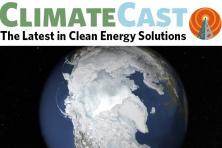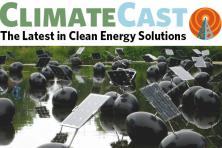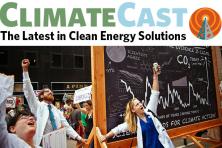Climate Action on 2018 Ballots and Growing Wedge Issue for Voters
Voters in the Pacific Northwest will have the chance to take some major climate action this fall. In Portland, OR the Portland Clean Energy Fund, is a ballot measure that would put a one percent charge on corporate retail revenue and invest funds in energy efficiency upgrades, clean energy job training, and programs to cut global warming pollution, with specific provisions to benefit communities of color and low-income residents. In Washington, the Secretary of State confirmed that Initiative 1631 qualified with the needed signatures for the statewide ballot, with the oil industry already spending money against the measure.
Climate change may also turn out to be a big voting issue for the rest of the country this November; new polling shows that a majority of US voters reflect an understanding of climate science and worry about climate change, including Republicans and Independents -- and is a growing focus for millennial and Latino voters.
Finally More Climate Coverage from the New York Times Magazine but. . .
According George Marshall in his book “Don’t Even Talk About it” in 2010, the New York Times “did not run a single lead item on climate change.” Now in 2018, the New York Times Magazine recently dedicated its entire Sunday issue to climate and the story of the 10-year period from 1979 to 1989 when humans first came to a broad understanding of climate change. The retrospective article tracked the efforts of American scientists, activists and politicians to raise the alarm about climate change decades ago. The article provides insight into just how thoroughly we understood the problem then and, arguably, how close we came to solving it, yet has stirred many strong reactions against the piece in particular given the author’s rejection of increased political partisanship or fossil fuel industry influence being key factors for current inaction on the global problem. The story generated some notable counter-pieces. Vox called the article “misguided and inconsistent.” Naomi Klein referred to it as a piece that “represents the kind of media commitment that the climate crisis has long deserved but almost never received” but also called it “spectacularly wrong in its central thesis.” Environmental journalists Robinson Meyer of The Atlantic, Rebecca Leber of Mother Jones, and Emily Atkins of The New Republic provided their own critiques of the article -- praising the piece, but also criticising the author for not including more coverage of the fossil fuel industry’s role in undermining climate science. Closer to home, Climate Solutions’ KC Golden refutes the piece’s dismissal of “any remaining hope for effective action as ‘irrational optimism’ and instead looks ahead to the Global Action Summit as a means for critical engagement coming soon.
Changes to the grid could make us more resilient to climate change
A new study from the National Renewable Energy Laboratory (NREL) presents a compelling argument on why converting the US to a national grid system would improve efficiency, smooth out peaks and troughs in demand, reduce the use of duplicative backup resources, allow for the integration of more renewable energy, and reduce power prices. Considering how hot temperatures strain the grid and the US has been experiencing one helluva nationwide heatwave this summer, implementing a national grid seems like to may be a good idea -- and a necessary one -- as climate change continues to warm the planet. Even the step of implementing a regional grid in the West could still make a huge difference, enabling California and other clean energy producers to share homegrown power with other western states, while providing a cost-effective way to decrease carbon pollution. The Environmental Defense Fund makes a strong case for a western regional power grid, which would “allow us to export our abundant solar power during the day, and import low-cost wind at night.”
Massive renewable projects offshore and on land
During “American Wind Week” last week, a major midwest utility announced it will spend more than $2 billion on renewable energy and double its number of wind sites. By 2030, 30 percent of the utility’s energy mix will come from renewables. And starting in 2021, Massachusetts electricity users will save $1.4 billion over the next 20 years thanks to the state’s first commercial-scale offshore wind farm.
In worldwide renewable news, Chile is utilizing renewables to power the country’s expansive mining industry. Chile’s Desierto Atacama is the world’s driest desert and gets more solar radiation than nearly any other spot on Earth. Pacific coast winds and the Andes Mountains also make Chile an ideal place for wind power. Chile isn’t the only country harnessing its the massive power of the sun; the world’s largest solar park will soon open next year 400 miles south of Cairo in Egypt’s Western Desert.
Automakers Wanting Electric Vehicles Stay in Fast Lane
In California, despite the Trump administration’s work to limit increased electric vehicle purchases in the state, major automakers say they have no intention of slowing or changing their electric vehicle plans. Across the country, GM’s electric vehicle sales are doing so well that the car manufacturer is close to reaching the 200,000-vehicle cap for the $7,500 federal tax incentive meant to encourage electric-vehicle sales. In Oregon, while AAA Oregon/Idaho and Trucking Associations Inc. had challenged the tax in November 2017, saying it violated Oregon's Constitution, the Supreme Court has approved funding of the state's Clean Vehicle Rebate Program.
Local Communities Suffering Economic Impacts As West Coast Still Burns
Due to the wildfire smoke, California’s Yosemite Park has been closed indefinitely during what would normally be the park’s busiest season. While the loss of revenue for the park is significant, it’s “gateway communities” that are suffering the biggest economic impacts. The economies of local communities like Oakhurst, Sonora and Mariposa are mostly or fully dependent on the park. That’s far from California’s only fire problem, however. The Mendocino Fire has now grown to be the state’s largest fire in modern California history. In Oregon, a wildfire near Dufur has grown to nearly 20,000 acres, threatening homes and communities and lightning sparked more fires in Washington State over the weekend. The ongoing commentary and coverage of the fires has included climate as a key factor to increasing the likelihood of fiercer and more frequent fires.
Even where the is no fire, there is still extreme heat. The sea surface temperature as measured on San Diego’s Scripps Pier in La Jolla hit 78.6 degrees earlier this month, the highest reading in the pier’s 102-year history. Across the region residents have been enduring heatwaves, while nearby wildfires have turned skies into a hazy shade of brown.
Will summer climate impacts finally shift some climate deniers?
Britain, Norway, Sweden, and Finland have been subject to previously unheard-of temperatures. Ouargla, Algeria reached a temperature of 124.2F, and is thought to be the highest temperature ever measured in Africa. Japan, Greece, Canada, and the US have also experienced record breaking heat. Australia is experiencing record drought -- with no end in sight. The north China plain, one of the most heavily populated regions in the world and the most important food-producing area in the huge nation, may soon regularly experience temperatures so hot that human life simply cannot be sustained. In Pakistan, retreating glaciers are creating perilous conditions from nearby villages. As the glaciers retreat, they leave behind lakes supported by ice dams. The dams are unstable, and often unpredictably burst, sending huge volumes of water rushing into the villages below them. The summer heatwave has also permanently changed Sweden’s landscape, melting the glacier that sits on top of what was the country’s highest mountain peak. The warming Arctic could be at the heart of what’s creating such prolonged heatwaves.
In brief: Bad news beyond impacts
New research finds that flood risk in the US could triple if climate change remains unchecked. “Rain-on-snow" floods are a particularly destructive type of flood that is on the rise due to climate change. Most common in mountain regions, these intense floods occur when heavy rains fall on top of deep snowpack, melting it.
Even more alarming is a new study that argues that the “domino-effect of climate events” could move the earth into a hothouse state -- a state of runaway climate change wherein our efforts to reduce emissions would be pointless. The study’s authors argue “we need to be much more proactive in that regard, not just ending greenhouse gas emissions as rapidly as possible, but also building resilience in the context of complex Earth system processes that we might not fully understand until it is too late.” No kidding.





